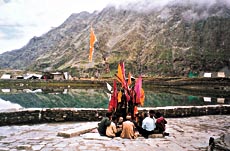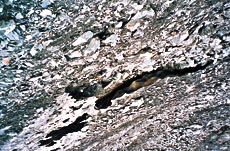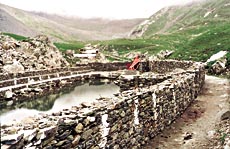A pilgrimage to
Mani Mahesh
By Anil K.
Sharma
AFTER scaling 10,000 feet and
walking for 11.5 km we reached Gauri Kund, a kilometre
below the sacred Mani Mahesh Lake. We were lucky for the
sky was not overcast and the sun was peeping out of the
hills as if Lord Shiva wanted to give us ‘clear
darshans’. Mount Kailash usually remains covered
with clouds. Women take a dip in Gauri Kund to seek the
blessings of the goddess.
 The pilgrimage to Mani Mahesh is
called "Man ka Mahesh" because it provides one
with spiritual satisfaction after viewing Mount Kailash
and taking a holy dip in the lake. The pilgrimage to Mani Mahesh is
called "Man ka Mahesh" because it provides one
with spiritual satisfaction after viewing Mount Kailash
and taking a holy dip in the lake.
The Mani Mahesh yatra
begins on Krishna Janmashtami and concludes on Radha
Ashtami every year. This year these fall on September 3
and 18. According to Mr Goverdhan Dass, J.E., P.W.D.,
Hadsar, more than 50,000 people visit Mani Mahesh every
year during the festival season. The yatra commences with
the start of "Chhari" from Chamba town to Mani
Mahesh in procession.
The twelve-hour journey
from Chandigarh to Chamba was quite comfortable. The day
chosen by us for this pilgrimage was much earlier to the
festival season. The famous Minjar Fair of Chamba, held
in the Indian month of Sravana every year, concluded a
week ago.
Next morning, we left
Chamba for Bharmaur. The road was narrow, surrounded by
high hills, as compared to the Pathankot-Chamba road. The
65-km distance to Bharmaur was covered in two hours.
 On our way to Bharmaur was a small
village, Bagga, which has been selected for stage II of
the Chamera National Hydroelectric Project. Earlier, it
was Chamera village where the power project was to be
originally situated, of which this is an extension. The
administrative offices of stage II are stationed at
Karian, near Chamba. Stage I of the project, already
functioning and generating electricity, is situated on
the Bani Khet-Chamba road. On our way to Bharmaur was a small
village, Bagga, which has been selected for stage II of
the Chamera National Hydroelectric Project. Earlier, it
was Chamera village where the power project was to be
originally situated, of which this is an extension. The
administrative offices of stage II are stationed at
Karian, near Chamba. Stage I of the project, already
functioning and generating electricity, is situated on
the Bani Khet-Chamba road.
The track from Hadsar to
Mani Mahesh is very narrow, Pilgrims have to climb along
either side of the Buddha Nullah.
Suresh Kumar, Executive
Engineer, PWD, Bharmaur, told me that the 1995 floods
washed away most of the track up to Dhanchhou, half way
towards the top, and caused great loss of property. The
department had to rebuild the track.
According to him, the
department erects temporary serais and toilets for
pilgrims and also maintains the 13-km track.
The journey on foot from
Hadsar starts at a height of 6000 feet and concludes at
13,500 feet at Mani Mahesh Lake.
 The Mani Mahesh yatra of Himachal does not
get much publicity as compared to the Amarnath yatra of
Jammu and Kashmir. There the state as well as Central
governments take keen interest. Although the Himachal
government has declared the Mani Mahesh yatra as a
state-level fair, there seems to be a growing apathy
towards it. The Mani Mahesh yatra of Himachal does not
get much publicity as compared to the Amarnath yatra of
Jammu and Kashmir. There the state as well as Central
governments take keen interest. Although the Himachal
government has declared the Mani Mahesh yatra as a
state-level fair, there seems to be a growing apathy
towards it.
We met people from
far-off places. Initially, we thought we might be only a
group of nine persons, which included two porters
travelling all alone, and that too, without food and
staying facilities on the way.
But we found a 15-member
scouts’ delegation from Ferozepore division of
Northern Railway based at Ludhiana, which was on its
return journey. Mr Vijay Sharma, a pilgrim from Assam,
said he was inspired by his friends who had visited this
beautiful place.
A five-member group,
including a couple from Asansol in West Bengal, told me
that they had started their yatra from Amarnath, visiting
the Vaishno Devi shrine near the Katra, Chintpurni
temple, Jawala Devi and Kangra Devi, and were now on
their way to the "most difficult yatra" of Mani
Mahesh.
There is a lake and a
four-faced marble idol of Lord Shiva at Mani Mahesh,
placed in the open near the lake. A boundary wall was
erected around the lake two years ago.
 According to pujaris Des Raj and
Tarsem Chand, four idols had been discovered by a rich
man of Hyderabad and he was ordained by Lord Shiva to
place one of these four idols here. Earlier, the idol was
placed at Dhanchhou and in course of time it reached Mani
Mahesh itself near the lake just opposite Mount Kailash,
believed to be the residing place of Lord Shiva. According to pujaris Des Raj and
Tarsem Chand, four idols had been discovered by a rich
man of Hyderabad and he was ordained by Lord Shiva to
place one of these four idols here. Earlier, the idol was
placed at Dhanchhou and in course of time it reached Mani
Mahesh itself near the lake just opposite Mount Kailash,
believed to be the residing place of Lord Shiva.
The height of Mount
Kailash is about 18,000 feet. The pujaris say that no one
could ever conquer it. He tells the story of a saint who
tried to scale Mount Kailash. When he was about to reach
the top, Lord Shiva turned him into a statue. They
pointed towards one of the corners believed to be the
body of the saint.
Another story of a
shepherd whom the Lord asked in dream to reach the top by
sacrificing at every step a lamb kept under his coat.
When the shepherd was about to reach, the place, he tried
to look under his coat and was turned into a statue that
very moment.
There is a
‘kund’ in the lake called a ‘Kala
Kund’. Any one who crosses it is considered to be
the most religious person and, according to a myth, if a
childless woman touches that person, she is blessed with
a child.
The young family members
of the pujari complain that although the whole area under
Hadsar panchayat has been declared a tribal area, all
residents get reservation in jobs except members of the
pujari’s family. They have requested the Himachal
government to end such discrimination.
Between Dhanchhou and
the glacier comes a flower valley. Beautiful flowers of
various colours and vegetation of a special kind are
found on these hills. Most of the pilgrims felt drowsy
during this part of the journey. The flowers and
vegetation on these hills are used in ayurvedic
medicines.
|

